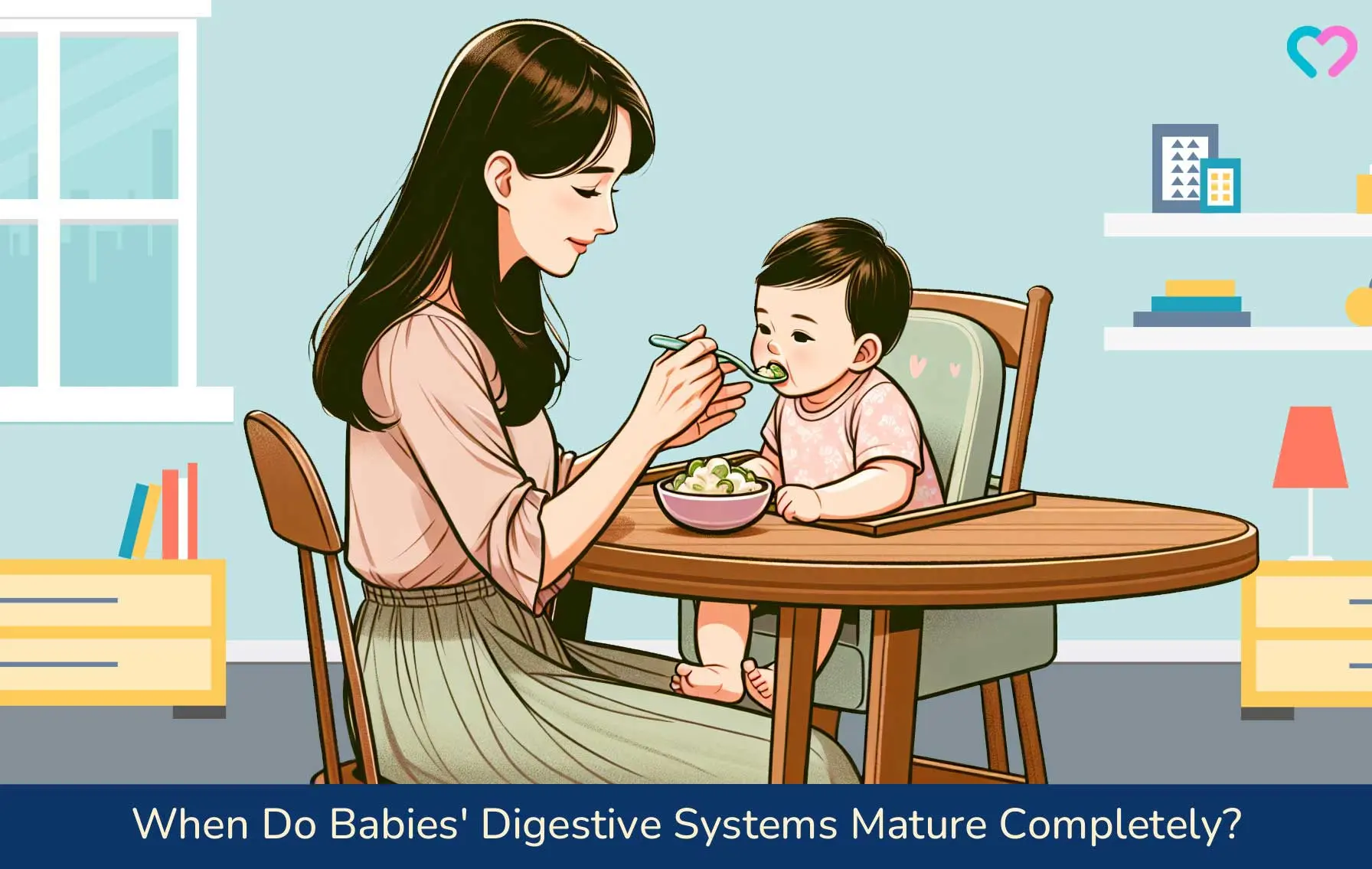
Image: Shutterstock
The placenta provides all the nourishment to the fetus in the womb. Once born, the baby’s digestive system becomes responsible for this process. The infant’s digestive system develops gradually while receiving nourishment from breast milk, the baby’s first food.
Once the baby is older than six months, their digestive system is mature enough to process solid food items and receive nourishment from them. Knowing the stages of your baby’s digestive development enables parents to make informed feeding decisions and identify potential digestive problems early. Keep reading to know the various parts and attributes of a baby’s digestive system.
Key Pointers
- Digestive system, including the mouth, esophagus, salivary gland, stomach, small intestines, large intestines, and the rectum, form in the mother’s womb itself.
- The digestive system is fully formed and functional in babies born at full-term.
- The digestive system continues to grow and mature through the first two years of the baby’s life.
Baby’s Digestive System: From Womb To Birth
The digestive system is responsible for breaking large food molecules into smaller ones. The broken molecules ensure adequate absorption of nutrients and the development of healthy bacteria in the gut (1).
Fetal digestive system (in the womb)
The gastrointestinal tract starts growing from the third week of gestation. By the fourth week, three distinct regions of the gut extend across the length of the embryo. These regions ultimately form different components of the gastrointestinal tract (2).
A fetal digestive system includes the mouth, esophagus, salivary glands, stomach, small intestine, large intestine, and rectum. All these digestive system parts develop in the womb itself. However, they stay functionally ineffectual until birth. This digestive system undergoes tremendous growth and functional maturation throughout pregnancy.
Newborn digestive system (full-term birth)

Image: Shutterstock
At full-term birth, the entire digestive system is ready to operate independently. While descending through the birth canal, the neonate system gets microbes via the vaginal microflora (3). It is a crucial occurrence as it contributes to the development of the newborn’s digestive system, including the intestinal microbial ecosystem.
This development continues as the newborn baby begins breastfeeding. For their first feed, most of the breastfed babies receive colostrum, the first milk produced after birth. Colostrum is rich in antibodies and nutrients such as fat, vitamins, and minerals that help the newborn baby grow (4). Besides, it helps in the development of the complex microorganism population that thrives in the baby’s digestive tract (5).
The changes in the baby’s body could cause a 7% loss of their birth weight within a few days (6). However, this weight loss is benign.
Newborn digestive system (preterm birth)
A premature birth leads to structural and functional differences between the digestive system of a preterm and full-term baby.
A preterm gut is immature and incapable of most functions a term gut can perform. A premature infant may not be ready to digest human milk, particularly the proteins present in it (7). Complete digestion of milk requires digestive juices such as gastric juice and pancreatic juice along with digestive enzymes, such as amylasei A digestive enzyme, primarily secreted by the pancreas and salivary glands, that breaks down carbohydrates into simple sugar. to digest starches and pancreatic lipaseiEnzyme secreted by the pancreas that breaks down fat in food to be absorbed by the intestines. for digestion of lipids. For these reasons, right after birth, a full-term infant is advised to breastfeed. However, this may not be the case with a preterm baby who needs time to be able to do the complex job of tolerating milk feeds.
Most babies, both preterm and full-term, spit up frequently due to the immature digestive system or a weak and immature lower esophageal sphincteriRing of muscles in the esophagus that controls the passage of food and liquid through the esophagus and prevents regurgitation. (8). However, it could also happen due to some digestive tract lining issues.
 Did you know?
Did you know?The Digestive Tract Lining Tissue
An infant’s digestive tract lining is a layer of mucus that protects the digestive tract from harmful microbes and other contaminants present in the food. At the time of birth, this lining is very thin and immature, which can increase the risk of digestive lining issues, such as inflammation and infections.
These gastrointestinal infections are dealt by antibodies present in breast milk, and this continues until the digestive mucosal liningiLayer of mucus lining the gastrointestinal tract that defends against bacteria, toxins, and other kinds of harmful substances. becomes mature. While breast milk is helping the digestive tract develop its lining, it also helps in the development of gut microbiotaiThe population of microorganisms in the digestive tract. . This is the reason why a mother’s dietary intake while breastfeeding should be healthy and planned.
In general, a baby’s digestive system continues to grow through the first two years of their life. This progression also has a direct link with the development of the baby’s immune system. Thus, the nutritional composition of the baby’s diet in the early years of life is considered crucial.
Why Should Solids Be Avoided Until Six Months?

Image: IStock
Breastfed or formula-fed infants can usually start solids by the age of six months. However, the right age may vary depending on the signs of readiness (9). Until then, solid foods are avoided because of the following reasons (10):
- The gag reflex is underdeveloped, thus posing the risk of choking.
- The frequency of breastfeeding would reduce, which can lead to a compromise in the intake of vital nutrients from breast milk.
- Proper digestion of solids would be difficult as the enzymes digesting carbohydrates develop at around six to seven months of age. The bile saltsiBile acids produced by the liver from cholesterol to aid in the digestion of fats and fat-soluble vitamins. and gastric lipase that help digest fat reach optimum levels between the ages of six and nine months.
- The larger food molecules might pass through the small intestine directly into the bloodstream as infants under six months have a permeable gut. This scenario could lead to gastrointestinal tract ailments and possible allergies (11).
 Be watchful
Be watchfulHow To Support Your Baby’s Digestive Learning Curve?
The changes in the digestive system are rapid. Parents could take a few measures to support these developments.
- Exclusive breastfeeding: Several research studies have shown the breastfed infants have better digestive, respiratory, and overall health due to the complex nutritional composition of breast milk (12). Therefore, mothers should exclusively breastfeed for six months and continue breastfeeding, if possible, for up to two years. The World Health Organization estimates that only 44% of infants between the ages of zero and six months are exclusively breastfed.
- Introduction of solid foods: You can support your baby’s gastrointestinal development by gradually introducing solids at around six months of age. As a general practice, you could do the following:

Image: IStock
- Introduce one food at a time and ensure the 6-month baby food contains easy-to-digest food items. Soft fruits such as apple, pureed meat, poultry, beans, and iron-fortified cereals are some options to try (13).
- As you add new food, wait three to five days, and watch if the food causes digestive discomfort to the baby. This way, you can identify a potential allergen.
- Begin feeding solids in cooked, mashed, or pureed form. As the baby grows and develops motor skills, you may transit to soft cooked food pieces (finger foods) by about nine months
- Try to add a variety of foods to your baby’s diet right from the start so that they may reap the benefits of these foods in the long run.
- Adjust the quantity of solid food to account for the consumption of breast milk or formula. Breast milk takes approximately an hour and a half to digest, while formula may take four to five hours.
- Practice hygiene: Hygiene measures while preparing baby food can reduce the risk of microbial and elemental contamination and prevent tummy troubles.

Image: Shutterstock
Frequently Asked Questions
1. How do I know if my baby has digestive problems?
The indicators of digestive systems problems in babies include vomiting or spitting up milk in large quantities, diarrhea, reflux, and colic (14).
2. How can I improve my baby’s digestive system?
Ensure the baby has an age-appropriate diet. Feed them several small meals a day rather than a few large meals. Let them eat at their own pace and burp them after each meal (15).
3. What is digestive overload in babies?
Digestive overload in babies refers to a condition where the baby’s digestive system becomes overwhelmed or burdened by the amount or type of food or milk consumed. In the case of infants, lactose overload can occur when breastfeeding mothers produce an excess amount of milk. This excess milk intake can lead to symptoms such as excessive gas, bloating, fussiness, green frothy poop, and difficulty in settling down after feeds (18).
4. What is colic in babies, and how does it affect their digestive system?
Colic in babies refers to excessive crying and fussiness without a known cause. While it doesn’t directly affect the digestive system, it is believed to be related to the immaturity and sensitivity of the baby’s digestive system. It can lead to gastrointestinal discomfort, such as gas and abdominal pain (19). Seeking guidance from healthcare professionals and implementing soothing techniques can help manage colic.
5. What is the role of probiotics in supporting a healthy baby’s digestive system?
Probiotics are widely believed to be beneficial bacteria that can support a healthy baby’s digestive system. They can help improve the balance of gut flora and boost the immune system. Probiotics may be introduced to babies through breastfeeding if the mother consumes foods or supplements containing them. Some formulas also contain added probiotics (20). However, it is important to consult with a healthcare professional before giving probiotics to infants.
6. What are the key milestones in a baby’s digestive development?
Important milestones in a baby’s digestive development include digesting breast milk or formula at birth, consuming solid foods around six months, and gradually shifting to a child’s diet by age two. These stages are essential for ensuring proper nutrient absorption and supporting healthy digestion.
The fetus digestive system begins to develop in the womb as early as the third week of pregnancy, but the placenta gives all the nutrition to the fetus. However, once a baby is born, the baby’s digestive system is in charge of this procedure. You can help their digestive system through adequate breastfeeding and feeding them solids in an age-appropriate manner. You can start experimenting with foods after their system gets stabilized and matured, which is around the age of six months. But, until then, breastfeed your baby and gradually introduce soft, easy-to-digest meals after six months.
Infographic: Ways To Support Your Baby’s Developing Digestive System
A baby’s digestive system matures over time. It is crucial to know the timelines to decide what’s best to feed a baby. It is also important to look out for food sensitivities as you introduce solids. The infographic below takes you through some key measures to support your baby’s developing digestive system.

Illustration: Momjunction Design Team
Illustration: Baby’s Digestive System: From Womb To Infancy

Image: Dall·E/MomJunction Design Team
If your baby is feeling uncomfortable due to some digestive issues you should check out this video. In this video, you will learn what the probable causes of this discomfort could be and how you can help ease such discomfort.
References
1. Digestive System; Medline Plus; US National Library of Medicine
2. Gastrointestinal Tract Development; UNSW Embryology
3. NARebecca E. Moore and Steven D. Townsend; Temporal development of the infant gut microbiome; The Royal Society PublishingES
4. Brian A. McGrath et al.; Composition and properties of bovine colostrum: a review; Springer Link
5. Newborn baby digestive tract; Microbewiki
6. Infant with Loss of 10% Birth Weight; Stanford Medicine
7. Veronique Demers-Mathieu et al.; Premature infants have lower gastric digestion capacity for human milk proteins than term infants; National Center For Biotechnology Information
8. Reflux in Infants; Medline Plus; US National Library of Medicine
9. Starting Solid Foods; Healthy Children; American Academy of Pediatrics
10. Weaning of infants; BMJ Journals
11. Mariona Pascal et al.; Microbiome and Allergic Diseases; National Center For Biotechnology Information
12. What’s In Breast Milk?; American Pregnancy Association
13. Do’s and Don’ts for Baby’s First Foods; Eat Right; Academy of Nutrition and Dietetics
14. Newborn Care: The First 6 Weeks; Missouri Baptist Medical Center
15. Gastrointestinal Problems; Stanford Children’s Health
16. Necrotizing Enterocolitis (NEC); Cleveland Clinic
17. Feeding your baby: When to start with solid foods; UNICEF18. Foremilk and Hindmilk; La Leche League International
19. Colic; Better Health Channel
20. Probiotics in Infant Formula; American Academy of Pediatrics
Community Experiences
Join the conversation and become a part of our nurturing community! Share your stories, experiences, and insights to connect with fellow parents.
Read full bio of Dr. Shashidhar A
Read full bio of Swati Patwal
Read full bio of Rohit Garoo
Read full bio of Ghazia Shah



















